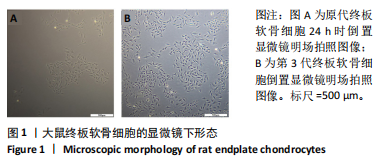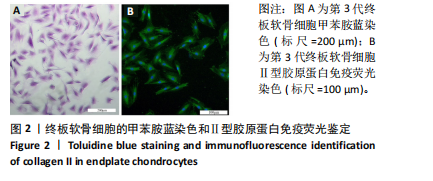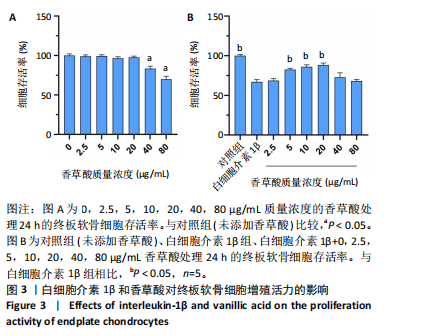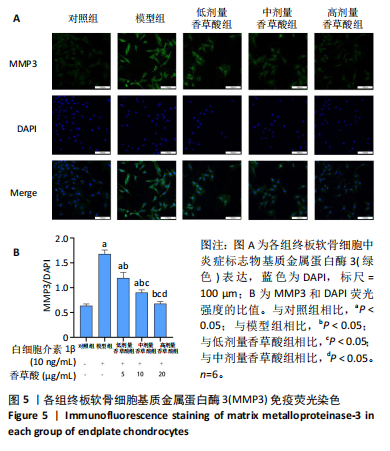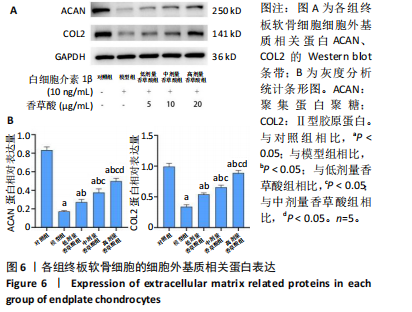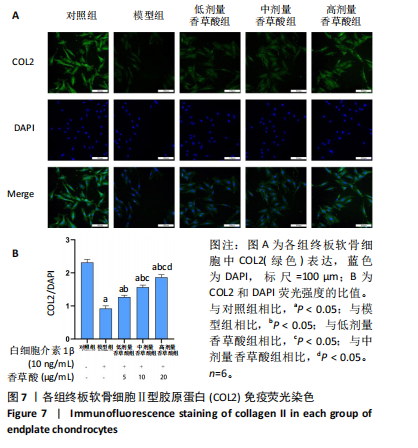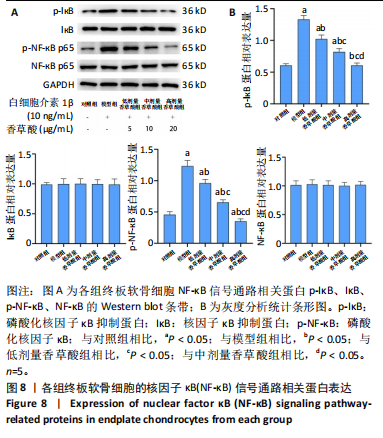[1] SALMAN A, KHAWAJA AS, BAIG K, et al. Comparing contribution of bony and cartilaginous endplate changes to intervertebral disc degeneration. Pak J Med Sci. 2024;40(7):1516-1522.
[2] LI K, YANG W, CHEN X, et al. A structured biomimetic nanoparticle as inflammatory factor sponge and autophagy-regulatory agent against intervertebral disc degeneration and discogenic pain. J Nanobiotechnology. 2024;22(1):486.
[3] SUN R, WANG F, ZHONG C, et al. The regulatory mechanism of cyclic GMP-AMP synthase on inflammatory senescence of nucleus pulposus cell. J Orthop Surg Res. 2024;19(1):421.
[4] ZHANG K, DU L, LI Z, et al. M2 macrophage-derived small extracellular vesicles ameliorate pyroptosis and intervertebral disc degeneration. Biomater Res. 2024;28:47.
[5] YU L, HAO YJ, REN ZN, et al. Ginsenoside Rg1 relieves rat intervertebral disc degeneration and inhibits IL-1β-induced nucleus pulposus cell apoptosis and inflammation via NF-κB signaling pathway. In Vitro Cell Dev Biol Anim. 2024;60(3):287-299.
[6] XIA Q, ZHAO Y, DONG H, et al. Progress in the study of molecular mechanisms of intervertebral disc degeneration. Biomed Pharmacother. 2024;174:116593.
[7] YANG G, LIU X, JING X, et al. Astaxanthin suppresses oxidative stress and calcification in vertebral cartilage endplate via activating Nrf-2/HO-1 signaling pathway. Int Immunopharmacol. 2023;119:110159.
[8] 张伟业, 展嘉文, 朱立国, 等. 循环牵张力作用下髓核外泌体对终板软骨细胞的影响[J]. 中国组织工程研究,2023,27(2):223-229.
[9] QUAN H, ZUO X, HUAN Y, et al. A systematic morphology study on the effect of high glucose on intervertebral disc endplate degeneration in mice. Heliyon. 2023;9(2):e13295.
[10] TIAN X, ZHAO H, YANG S, et al. The effect of diabetes mellitus on lumbar disc degeneration: an MRI-based study. Eur Spine J. 2024;33(5): 1999-2006.
[11] ZHANG Z, LIN J, TIAN N, et al. Melatonin protects vertebral endplate chondrocytes against apoptosis and calcification via the Sirt1-autophagy pathway. J Cell Mol Med. 2019;23(1):177-193.
[12] QUE Y, WONG C, QIU J, et al. Maslinic acid alleviates intervertebral disc degeneration by inhibiting the PI3K/AKT and NF-κB signaling pathways. Acta Biochim Biophys Sin (Shanghai). 2024;56(5):776-788.
[13] CHEN E, LI M, LIAO Z, et al. Phillyrin reduces ROS production to alleviate the progression of intervertebral disc degeneration by inhibiting NF-κB pathway. J Orthop Surg Res. 2024;19(1):308.
[14] CHEN L, ZHONG Y, SUN S, et al. HTRA1 from OVX rat osteoclasts causes detrimental effects on endplate chondrocytes through NF-κB. Heliyon. 2023;9(6):e17595.
[15] WANG X, ZENG Q, GE Q, et al. Protective effects of Shensuitongzhi formula on intervertebral disc degeneration via downregulation of NF-κB signaling pathway and inflammatory response. J Orthop Surg Res. 2024;19(1):80.
[16] 谢越, 翟伟峰, 郭际, 等. 椎间盘退变相关焦亡基因的综合分析[J]. 中国组织工程研究 ,2024,28(21):3438-3444.
[17] ZOU K, YING J, XU H, et al. Aucubin alleviates intervertebral disc degeneration by repressing NF-κB-NLRP3 inflammasome activation in endplate chondrocytes. J Inflamm Res. 2023;16:5899-5913.
[18] CHOI GY, LEE IS, MOON E, et al. Ameliorative effect of vanillic acid against scopolamine-induced learning and memory impairment in rat via attenuation of oxidative stress and dysfunctional synaptic plasticity. Biomed Pharmacother. 2024;177:117000.
[19] GHADERI S, GHOLIPOUR P, KOMAKI A, et al. Underlying mechanisms behind the neuroprotective effect of vanillic acid against diabetes-associated cognitive decline: An in vivo study in a rat model. Phytother Res. 2024;38(3):1262-1277.
[20] SWEED NM, ZAAFAN MA, EL-BISHBISHY MH, et al. The pulmonary protective potential of vanillic acid-loaded TPGS-liposomes: modulation of miR-217/MAPK/NF-κb signalling pathway. J Microencapsul. 2024; 41(4):255-268.
[21] ZIADLOU R, BARBERO A, MARTIN I, et al. Anti-inflammatory and chondroprotective effects of vanillic acid and Epimedin C in human osteoarthritic chondrocytes. Biomolecules. 2020;10(6):932.
[22] HUANG X, XI Y, MAO Z, et al. Vanillic acid attenuates cartilage degeneration by regulating the MAPK and PI3K/AKT/NF-κB pathways. Eur J Pharmacol. 2019;859:172481.
[23] NI J, ZHANG L, FENG G, et al. Vanillic acid restores homeostasis of intestinal epithelium in colitis through inhibiting CA9/STIM1-mediated ferroptosis. Pharmacol Res. 2024;202:107128.
[24] BAI H, ZHANG Z, LI Y, et al. L-theanine reduced the development of knee osteoarthritis in rats via its anti-inflammation and anti-matrix degradation actions: in vivo and in vitro study. Nutrients. 2020; 12(7):1988.
[25] CHEN X, ZHANG A, ZHAO K, et al. The role of oxidative stress in intervertebral disc degeneration: Mechanisms and therapeutic implications. Ageing Res Rev. 2024;98:102323.
[26] BAHAR ME, HWANG JS, LAI TH, et al. The survival of human intervertebral disc nucleus pulposus cells under oxidative stress relies on the autophagy triggered by delphinidin. Antioxidants (Basel). 2024; 13(7):759.
[27] LI L, ZHANG G, YANG Z, et al. Stress-activated protein kinases in intervertebral disc degeneration: unraveling the impact of JNK and p38 MAPK. Biomolecules. 2024;14(4):393.
[28] SONG C, HU P, PENG R, et al. Bioenergetic dysfunction in the pathogenesis of intervertebral disc degeneration. Pharmacol Res. 2024;202:107119.
[29] WANG J, JING X, LIU X, et al. Naringin safeguards vertebral endplate chondrocytes from apoptosis and NLRP3 inflammasome activation through SIRT3-mediated mitophagy. Int Immunopharmacol. 2024; 140:112801.
[30] JING X, WANG W, HE X, et al. HIF-2α/TFR1 mediated iron homeostasis disruption aggravates cartilage endplate degeneration through ferroptotic damage and mtDNA release: A new mechanism of intervertebral disc degeneration. J Orthop Translat. 2024;46:65-78.
[31] WU W, TANG J, BAO W, et al. Thiols-rich peptide from water buffalo horn keratin alleviates oxidative stress and inflammation through co-regulating Nrf2/Hmox-1 and NF-κB signaling pathway. Free Radic Biol Med. 2024;223:131-143.
[32] HUANG C, ZOU K, WANG Y, et al. Esculetin alleviates IL-1β-evoked nucleus pulposus cell death, extracellular matrix remodeling, and inflammation by activating Nrf2/HO-1/NF-κb. ACS Omega. 2024;9(1): 817-827.
[33] BAINS M, KAUR J, AKHTAR A, et al. Anti-inflammatory effects of ellagic acid and vanillic acid against quinolinic acid-induced rat model of Huntington’s disease by targeting IKK-NF-κB pathway. Eur J Pharmacol. 2022;934:175316.
[34] KHALIL HE, ABDELWAHAB MF, EMEKA PM, et al. Brassica oleracea L. var. botrytis leaf extract alleviates gentamicin-induced hepatorenal injury in rats-possible modulation of IL-1β and NF-κB activity assisted with computational approach. Life (Basel). 2022;12(9):1370.
[35] SINGH B, KUMAR A, SINGH H, et al. Protective effect of vanillic acid against diabetes and diabetic nephropathy by attenuating oxidative stress and upregulation of NF-κB, TNF-α and COX-2 proteins in rats. Phytother Res. 2022;36(3):1338-1352. |
